Health Needs Analysis and Services
VerifiedAdded on 2020/06/06
|11
|3438
|48
AI Summary
This assignment delves into the diverse health care needs of various population groups, focusing on pregnant women with co-occurring disorders, young and midlife stroke survivors, and children with special educational needs. It examines the clinical requirements of these individuals and the impact on primary care and long-term follow-up services. The analysis also considers disparities in healthcare quality among Asian children with special health care needs and the broader landscape of transgender health care. The document highlights the importance of addressing these unique needs through appropriate policies, legal frameworks, and medical practices.
Contribute Materials
Your contribution can guide someone’s learning journey. Share your
documents today.
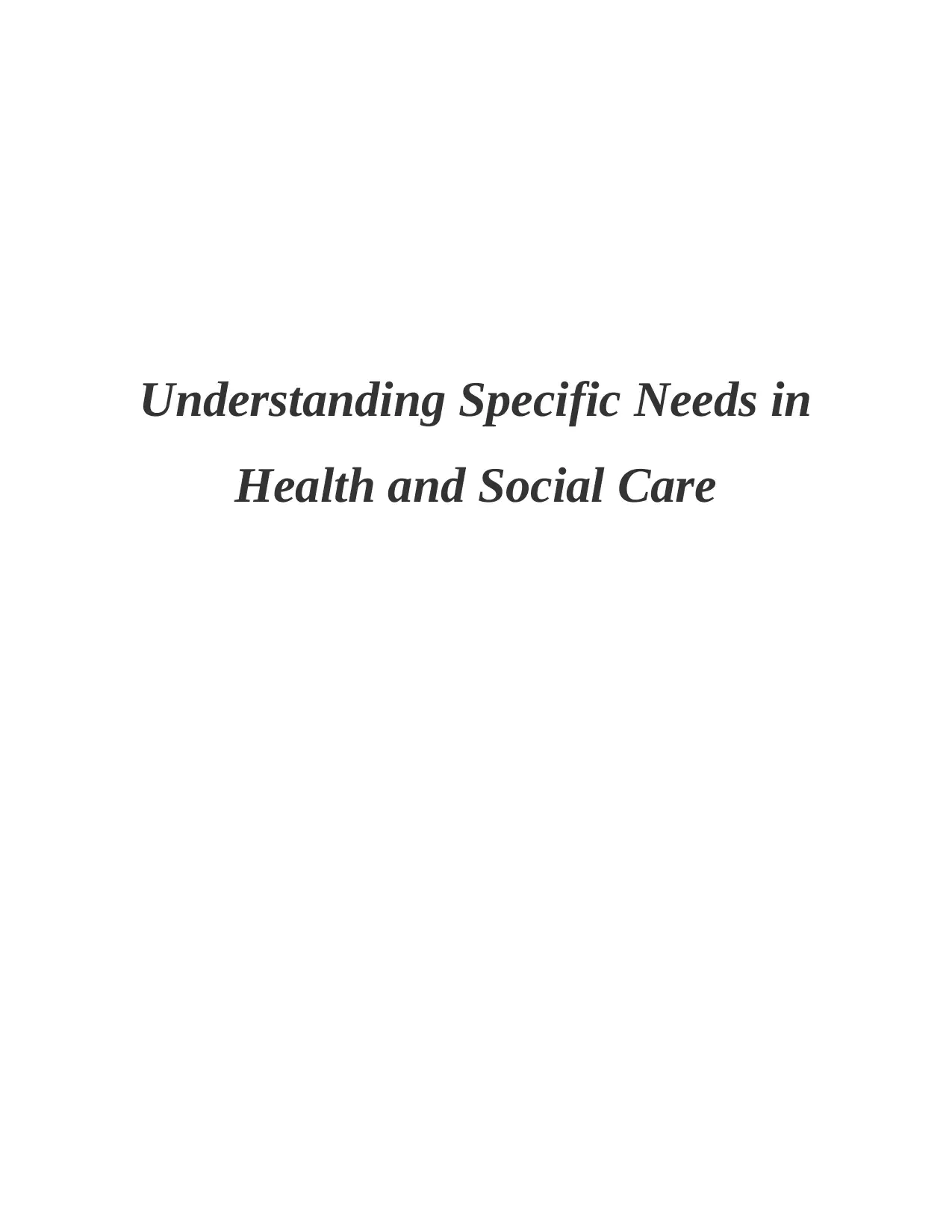
Understanding Specific Needs in
Health and Social Care
Health and Social Care
Secure Best Marks with AI Grader
Need help grading? Try our AI Grader for instant feedback on your assignments.
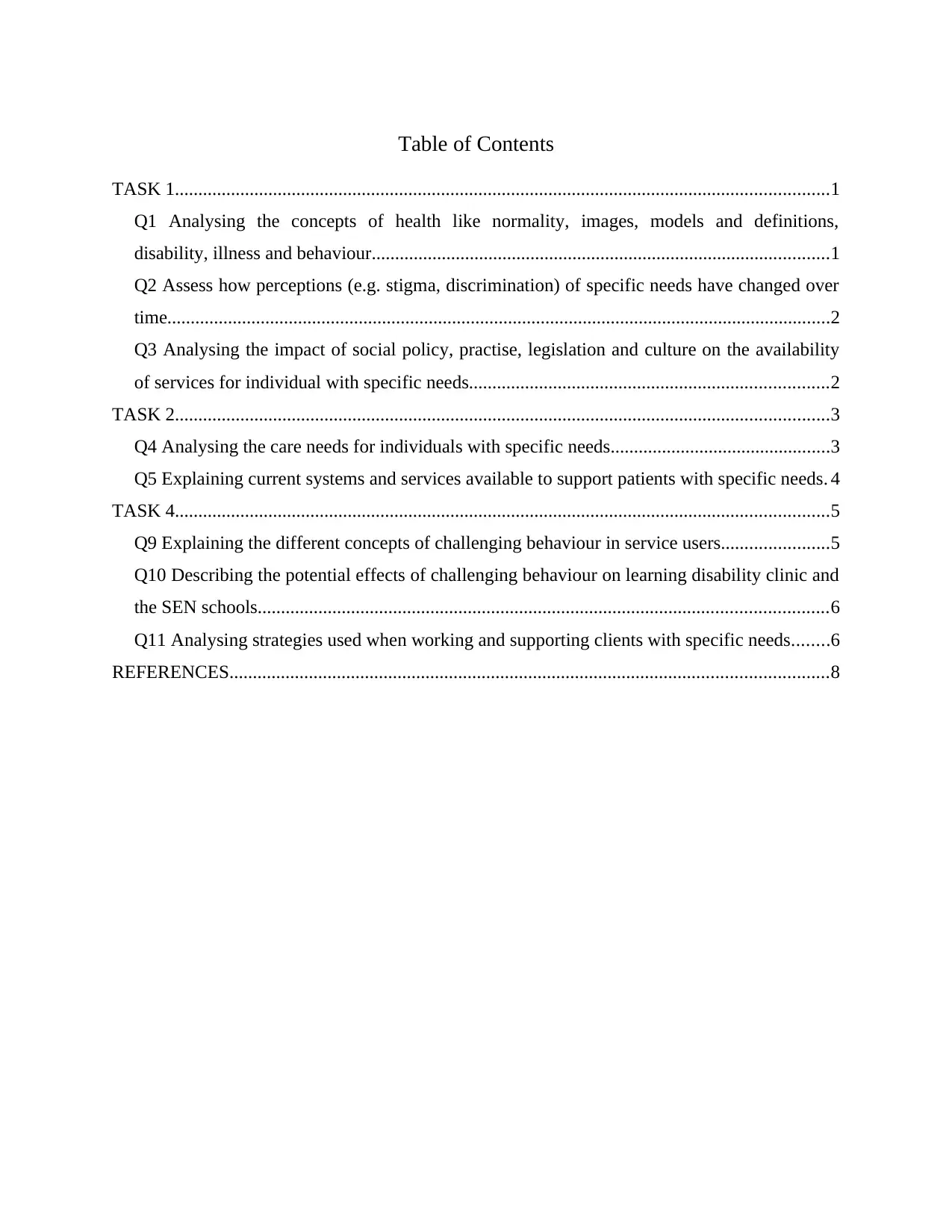
Table of Contents
TASK 1............................................................................................................................................1
Q1 Analysing the concepts of health like normality, images, models and definitions,
disability, illness and behaviour..................................................................................................1
Q2 Assess how perceptions (e.g. stigma, discrimination) of specific needs have changed over
time..............................................................................................................................................2
Q3 Analysing the impact of social policy, practise, legislation and culture on the availability
of services for individual with specific needs.............................................................................2
TASK 2............................................................................................................................................3
Q4 Analysing the care needs for individuals with specific needs...............................................3
Q5 Explaining current systems and services available to support patients with specific needs. 4
TASK 4............................................................................................................................................5
Q9 Explaining the different concepts of challenging behaviour in service users.......................5
Q10 Describing the potential effects of challenging behaviour on learning disability clinic and
the SEN schools..........................................................................................................................6
Q11 Analysing strategies used when working and supporting clients with specific needs........6
REFERENCES................................................................................................................................8
TASK 1............................................................................................................................................1
Q1 Analysing the concepts of health like normality, images, models and definitions,
disability, illness and behaviour..................................................................................................1
Q2 Assess how perceptions (e.g. stigma, discrimination) of specific needs have changed over
time..............................................................................................................................................2
Q3 Analysing the impact of social policy, practise, legislation and culture on the availability
of services for individual with specific needs.............................................................................2
TASK 2............................................................................................................................................3
Q4 Analysing the care needs for individuals with specific needs...............................................3
Q5 Explaining current systems and services available to support patients with specific needs. 4
TASK 4............................................................................................................................................5
Q9 Explaining the different concepts of challenging behaviour in service users.......................5
Q10 Describing the potential effects of challenging behaviour on learning disability clinic and
the SEN schools..........................................................................................................................6
Q11 Analysing strategies used when working and supporting clients with specific needs........6
REFERENCES................................................................................................................................8
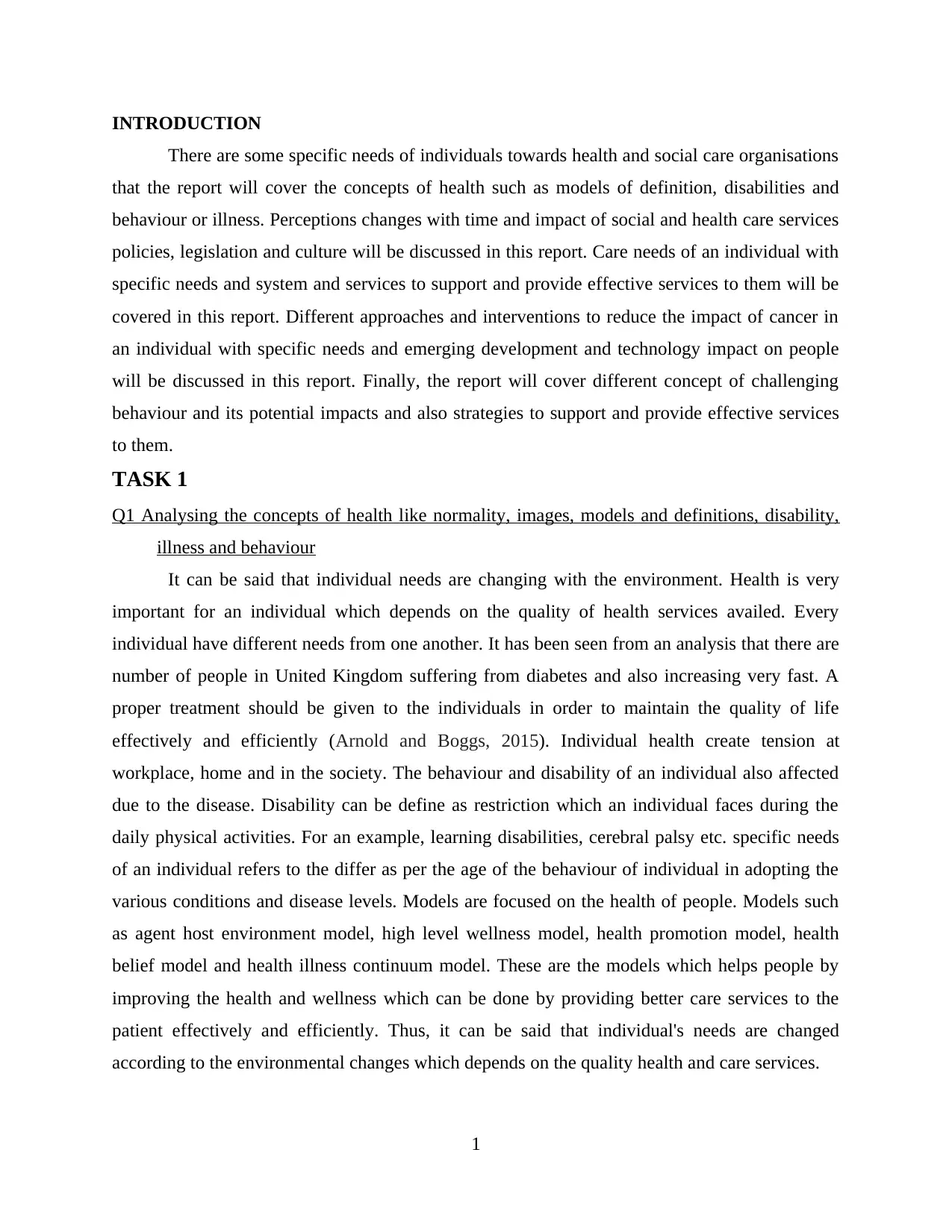
INTRODUCTION
There are some specific needs of individuals towards health and social care organisations
that the report will cover the concepts of health such as models of definition, disabilities and
behaviour or illness. Perceptions changes with time and impact of social and health care services
policies, legislation and culture will be discussed in this report. Care needs of an individual with
specific needs and system and services to support and provide effective services to them will be
covered in this report. Different approaches and interventions to reduce the impact of cancer in
an individual with specific needs and emerging development and technology impact on people
will be discussed in this report. Finally, the report will cover different concept of challenging
behaviour and its potential impacts and also strategies to support and provide effective services
to them.
TASK 1
Q1 Analysing the concepts of health like normality, images, models and definitions, disability,
illness and behaviour
It can be said that individual needs are changing with the environment. Health is very
important for an individual which depends on the quality of health services availed. Every
individual have different needs from one another. It has been seen from an analysis that there are
number of people in United Kingdom suffering from diabetes and also increasing very fast. A
proper treatment should be given to the individuals in order to maintain the quality of life
effectively and efficiently (Arnold and Boggs, 2015). Individual health create tension at
workplace, home and in the society. The behaviour and disability of an individual also affected
due to the disease. Disability can be define as restriction which an individual faces during the
daily physical activities. For an example, learning disabilities, cerebral palsy etc. specific needs
of an individual refers to the differ as per the age of the behaviour of individual in adopting the
various conditions and disease levels. Models are focused on the health of people. Models such
as agent host environment model, high level wellness model, health promotion model, health
belief model and health illness continuum model. These are the models which helps people by
improving the health and wellness which can be done by providing better care services to the
patient effectively and efficiently. Thus, it can be said that individual's needs are changed
according to the environmental changes which depends on the quality health and care services.
1
There are some specific needs of individuals towards health and social care organisations
that the report will cover the concepts of health such as models of definition, disabilities and
behaviour or illness. Perceptions changes with time and impact of social and health care services
policies, legislation and culture will be discussed in this report. Care needs of an individual with
specific needs and system and services to support and provide effective services to them will be
covered in this report. Different approaches and interventions to reduce the impact of cancer in
an individual with specific needs and emerging development and technology impact on people
will be discussed in this report. Finally, the report will cover different concept of challenging
behaviour and its potential impacts and also strategies to support and provide effective services
to them.
TASK 1
Q1 Analysing the concepts of health like normality, images, models and definitions, disability,
illness and behaviour
It can be said that individual needs are changing with the environment. Health is very
important for an individual which depends on the quality of health services availed. Every
individual have different needs from one another. It has been seen from an analysis that there are
number of people in United Kingdom suffering from diabetes and also increasing very fast. A
proper treatment should be given to the individuals in order to maintain the quality of life
effectively and efficiently (Arnold and Boggs, 2015). Individual health create tension at
workplace, home and in the society. The behaviour and disability of an individual also affected
due to the disease. Disability can be define as restriction which an individual faces during the
daily physical activities. For an example, learning disabilities, cerebral palsy etc. specific needs
of an individual refers to the differ as per the age of the behaviour of individual in adopting the
various conditions and disease levels. Models are focused on the health of people. Models such
as agent host environment model, high level wellness model, health promotion model, health
belief model and health illness continuum model. These are the models which helps people by
improving the health and wellness which can be done by providing better care services to the
patient effectively and efficiently. Thus, it can be said that individual's needs are changed
according to the environmental changes which depends on the quality health and care services.
1
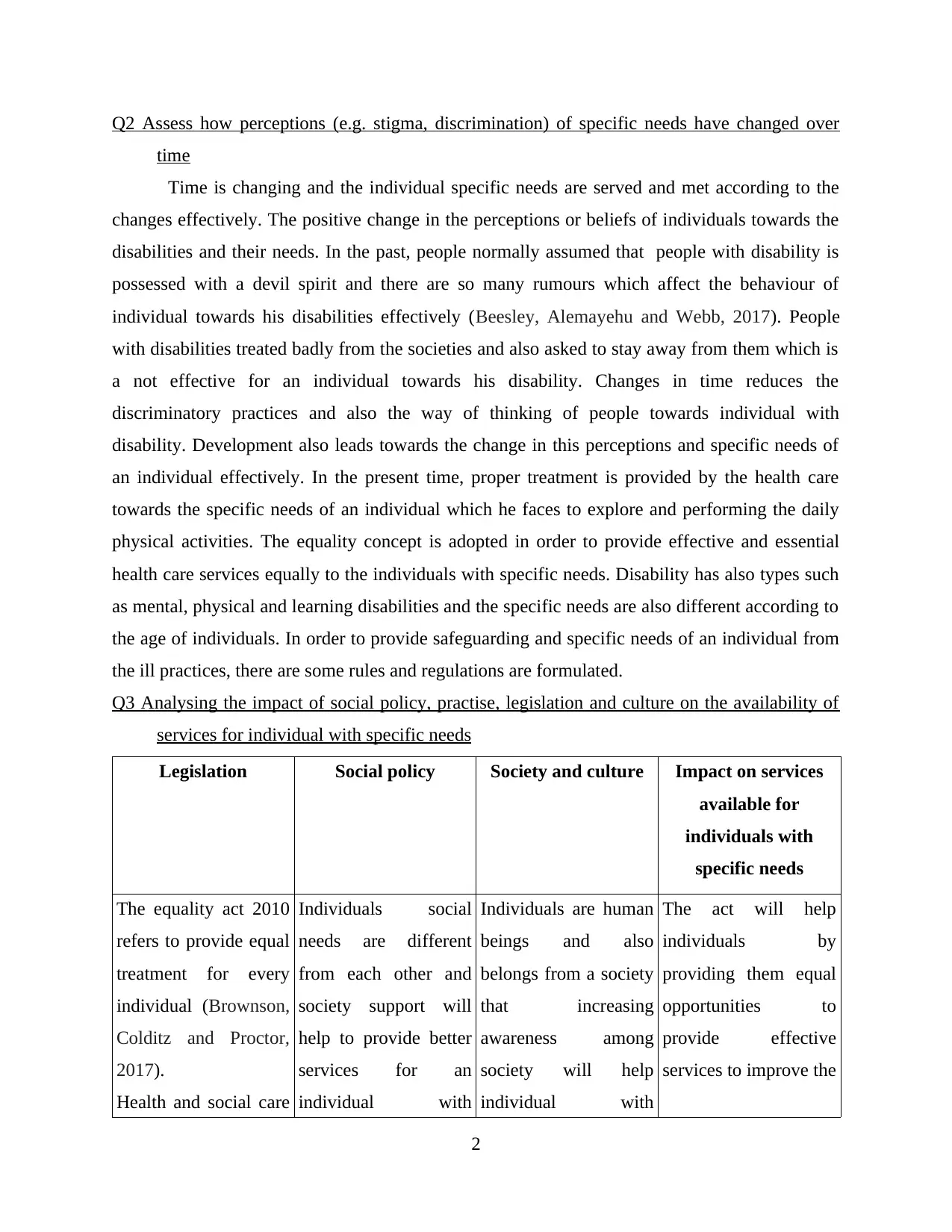
Q2 Assess how perceptions (e.g. stigma, discrimination) of specific needs have changed over
time
Time is changing and the individual specific needs are served and met according to the
changes effectively. The positive change in the perceptions or beliefs of individuals towards the
disabilities and their needs. In the past, people normally assumed that people with disability is
possessed with a devil spirit and there are so many rumours which affect the behaviour of
individual towards his disabilities effectively (Beesley, Alemayehu and Webb, 2017). People
with disabilities treated badly from the societies and also asked to stay away from them which is
a not effective for an individual towards his disability. Changes in time reduces the
discriminatory practices and also the way of thinking of people towards individual with
disability. Development also leads towards the change in this perceptions and specific needs of
an individual effectively. In the present time, proper treatment is provided by the health care
towards the specific needs of an individual which he faces to explore and performing the daily
physical activities. The equality concept is adopted in order to provide effective and essential
health care services equally to the individuals with specific needs. Disability has also types such
as mental, physical and learning disabilities and the specific needs are also different according to
the age of individuals. In order to provide safeguarding and specific needs of an individual from
the ill practices, there are some rules and regulations are formulated.
Q3 Analysing the impact of social policy, practise, legislation and culture on the availability of
services for individual with specific needs
Legislation Social policy Society and culture Impact on services
available for
individuals with
specific needs
The equality act 2010
refers to provide equal
treatment for every
individual (Brownson,
Colditz and Proctor,
2017).
Health and social care
Individuals social
needs are different
from each other and
society support will
help to provide better
services for an
individual with
Individuals are human
beings and also
belongs from a society
that increasing
awareness among
society will help
individual with
The act will help
individuals by
providing them equal
opportunities to
provide effective
services to improve the
2
time
Time is changing and the individual specific needs are served and met according to the
changes effectively. The positive change in the perceptions or beliefs of individuals towards the
disabilities and their needs. In the past, people normally assumed that people with disability is
possessed with a devil spirit and there are so many rumours which affect the behaviour of
individual towards his disabilities effectively (Beesley, Alemayehu and Webb, 2017). People
with disabilities treated badly from the societies and also asked to stay away from them which is
a not effective for an individual towards his disability. Changes in time reduces the
discriminatory practices and also the way of thinking of people towards individual with
disability. Development also leads towards the change in this perceptions and specific needs of
an individual effectively. In the present time, proper treatment is provided by the health care
towards the specific needs of an individual which he faces to explore and performing the daily
physical activities. The equality concept is adopted in order to provide effective and essential
health care services equally to the individuals with specific needs. Disability has also types such
as mental, physical and learning disabilities and the specific needs are also different according to
the age of individuals. In order to provide safeguarding and specific needs of an individual from
the ill practices, there are some rules and regulations are formulated.
Q3 Analysing the impact of social policy, practise, legislation and culture on the availability of
services for individual with specific needs
Legislation Social policy Society and culture Impact on services
available for
individuals with
specific needs
The equality act 2010
refers to provide equal
treatment for every
individual (Brownson,
Colditz and Proctor,
2017).
Health and social care
Individuals social
needs are different
from each other and
society support will
help to provide better
services for an
individual with
Individuals are human
beings and also
belongs from a society
that increasing
awareness among
society will help
individual with
The act will help
individuals by
providing them equal
opportunities to
provide effective
services to improve the
2
Secure Best Marks with AI Grader
Need help grading? Try our AI Grader for instant feedback on your assignments.
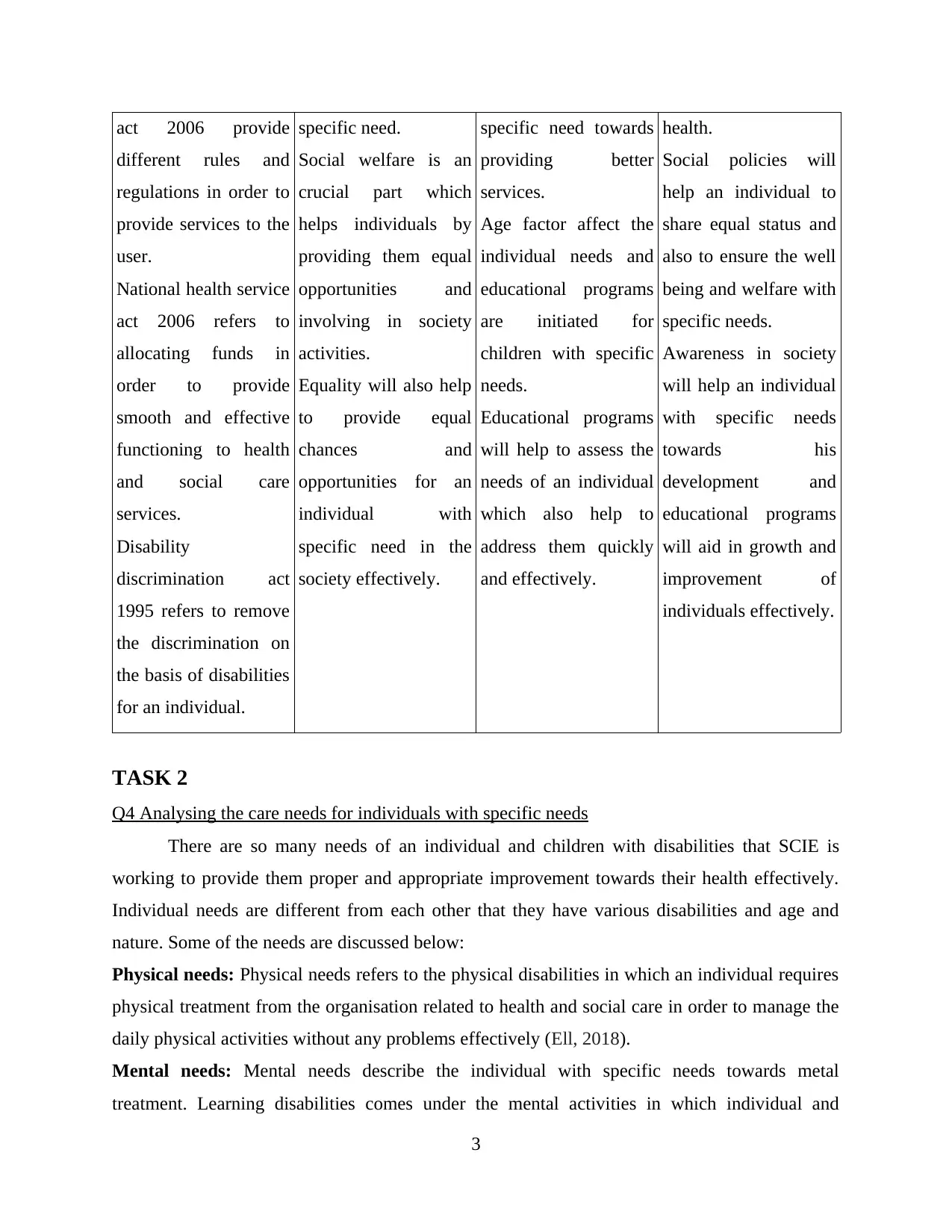
act 2006 provide
different rules and
regulations in order to
provide services to the
user.
National health service
act 2006 refers to
allocating funds in
order to provide
smooth and effective
functioning to health
and social care
services.
Disability
discrimination act
1995 refers to remove
the discrimination on
the basis of disabilities
for an individual.
specific need.
Social welfare is an
crucial part which
helps individuals by
providing them equal
opportunities and
involving in society
activities.
Equality will also help
to provide equal
chances and
opportunities for an
individual with
specific need in the
society effectively.
specific need towards
providing better
services.
Age factor affect the
individual needs and
educational programs
are initiated for
children with specific
needs.
Educational programs
will help to assess the
needs of an individual
which also help to
address them quickly
and effectively.
health.
Social policies will
help an individual to
share equal status and
also to ensure the well
being and welfare with
specific needs.
Awareness in society
will help an individual
with specific needs
towards his
development and
educational programs
will aid in growth and
improvement of
individuals effectively.
TASK 2
Q4 Analysing the care needs for individuals with specific needs
There are so many needs of an individual and children with disabilities that SCIE is
working to provide them proper and appropriate improvement towards their health effectively.
Individual needs are different from each other that they have various disabilities and age and
nature. Some of the needs are discussed below:
Physical needs: Physical needs refers to the physical disabilities in which an individual requires
physical treatment from the organisation related to health and social care in order to manage the
daily physical activities without any problems effectively (Ell, 2018).
Mental needs: Mental needs describe the individual with specific needs towards metal
treatment. Learning disabilities comes under the mental activities in which individual and
3
different rules and
regulations in order to
provide services to the
user.
National health service
act 2006 refers to
allocating funds in
order to provide
smooth and effective
functioning to health
and social care
services.
Disability
discrimination act
1995 refers to remove
the discrimination on
the basis of disabilities
for an individual.
specific need.
Social welfare is an
crucial part which
helps individuals by
providing them equal
opportunities and
involving in society
activities.
Equality will also help
to provide equal
chances and
opportunities for an
individual with
specific need in the
society effectively.
specific need towards
providing better
services.
Age factor affect the
individual needs and
educational programs
are initiated for
children with specific
needs.
Educational programs
will help to assess the
needs of an individual
which also help to
address them quickly
and effectively.
health.
Social policies will
help an individual to
share equal status and
also to ensure the well
being and welfare with
specific needs.
Awareness in society
will help an individual
with specific needs
towards his
development and
educational programs
will aid in growth and
improvement of
individuals effectively.
TASK 2
Q4 Analysing the care needs for individuals with specific needs
There are so many needs of an individual and children with disabilities that SCIE is
working to provide them proper and appropriate improvement towards their health effectively.
Individual needs are different from each other that they have various disabilities and age and
nature. Some of the needs are discussed below:
Physical needs: Physical needs refers to the physical disabilities in which an individual requires
physical treatment from the organisation related to health and social care in order to manage the
daily physical activities without any problems effectively (Ell, 2018).
Mental needs: Mental needs describe the individual with specific needs towards metal
treatment. Learning disabilities comes under the mental activities in which individual and
3
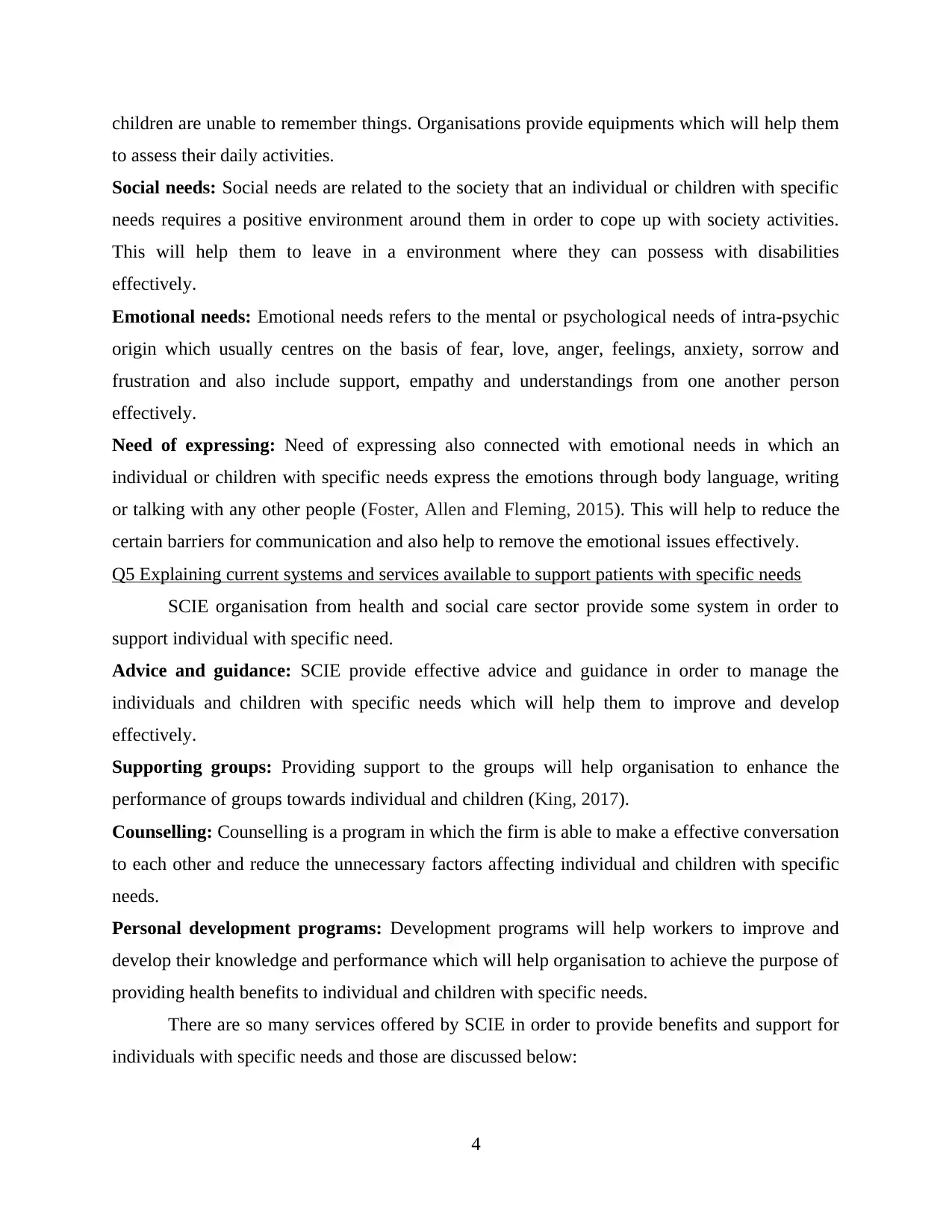
children are unable to remember things. Organisations provide equipments which will help them
to assess their daily activities.
Social needs: Social needs are related to the society that an individual or children with specific
needs requires a positive environment around them in order to cope up with society activities.
This will help them to leave in a environment where they can possess with disabilities
effectively.
Emotional needs: Emotional needs refers to the mental or psychological needs of intra-psychic
origin which usually centres on the basis of fear, love, anger, feelings, anxiety, sorrow and
frustration and also include support, empathy and understandings from one another person
effectively.
Need of expressing: Need of expressing also connected with emotional needs in which an
individual or children with specific needs express the emotions through body language, writing
or talking with any other people (Foster, Allen and Fleming, 2015). This will help to reduce the
certain barriers for communication and also help to remove the emotional issues effectively.
Q5 Explaining current systems and services available to support patients with specific needs
SCIE organisation from health and social care sector provide some system in order to
support individual with specific need.
Advice and guidance: SCIE provide effective advice and guidance in order to manage the
individuals and children with specific needs which will help them to improve and develop
effectively.
Supporting groups: Providing support to the groups will help organisation to enhance the
performance of groups towards individual and children (King, 2017).
Counselling: Counselling is a program in which the firm is able to make a effective conversation
to each other and reduce the unnecessary factors affecting individual and children with specific
needs.
Personal development programs: Development programs will help workers to improve and
develop their knowledge and performance which will help organisation to achieve the purpose of
providing health benefits to individual and children with specific needs.
There are so many services offered by SCIE in order to provide benefits and support for
individuals with specific needs and those are discussed below:
4
to assess their daily activities.
Social needs: Social needs are related to the society that an individual or children with specific
needs requires a positive environment around them in order to cope up with society activities.
This will help them to leave in a environment where they can possess with disabilities
effectively.
Emotional needs: Emotional needs refers to the mental or psychological needs of intra-psychic
origin which usually centres on the basis of fear, love, anger, feelings, anxiety, sorrow and
frustration and also include support, empathy and understandings from one another person
effectively.
Need of expressing: Need of expressing also connected with emotional needs in which an
individual or children with specific needs express the emotions through body language, writing
or talking with any other people (Foster, Allen and Fleming, 2015). This will help to reduce the
certain barriers for communication and also help to remove the emotional issues effectively.
Q5 Explaining current systems and services available to support patients with specific needs
SCIE organisation from health and social care sector provide some system in order to
support individual with specific need.
Advice and guidance: SCIE provide effective advice and guidance in order to manage the
individuals and children with specific needs which will help them to improve and develop
effectively.
Supporting groups: Providing support to the groups will help organisation to enhance the
performance of groups towards individual and children (King, 2017).
Counselling: Counselling is a program in which the firm is able to make a effective conversation
to each other and reduce the unnecessary factors affecting individual and children with specific
needs.
Personal development programs: Development programs will help workers to improve and
develop their knowledge and performance which will help organisation to achieve the purpose of
providing health benefits to individual and children with specific needs.
There are so many services offered by SCIE in order to provide benefits and support for
individuals with specific needs and those are discussed below:
4
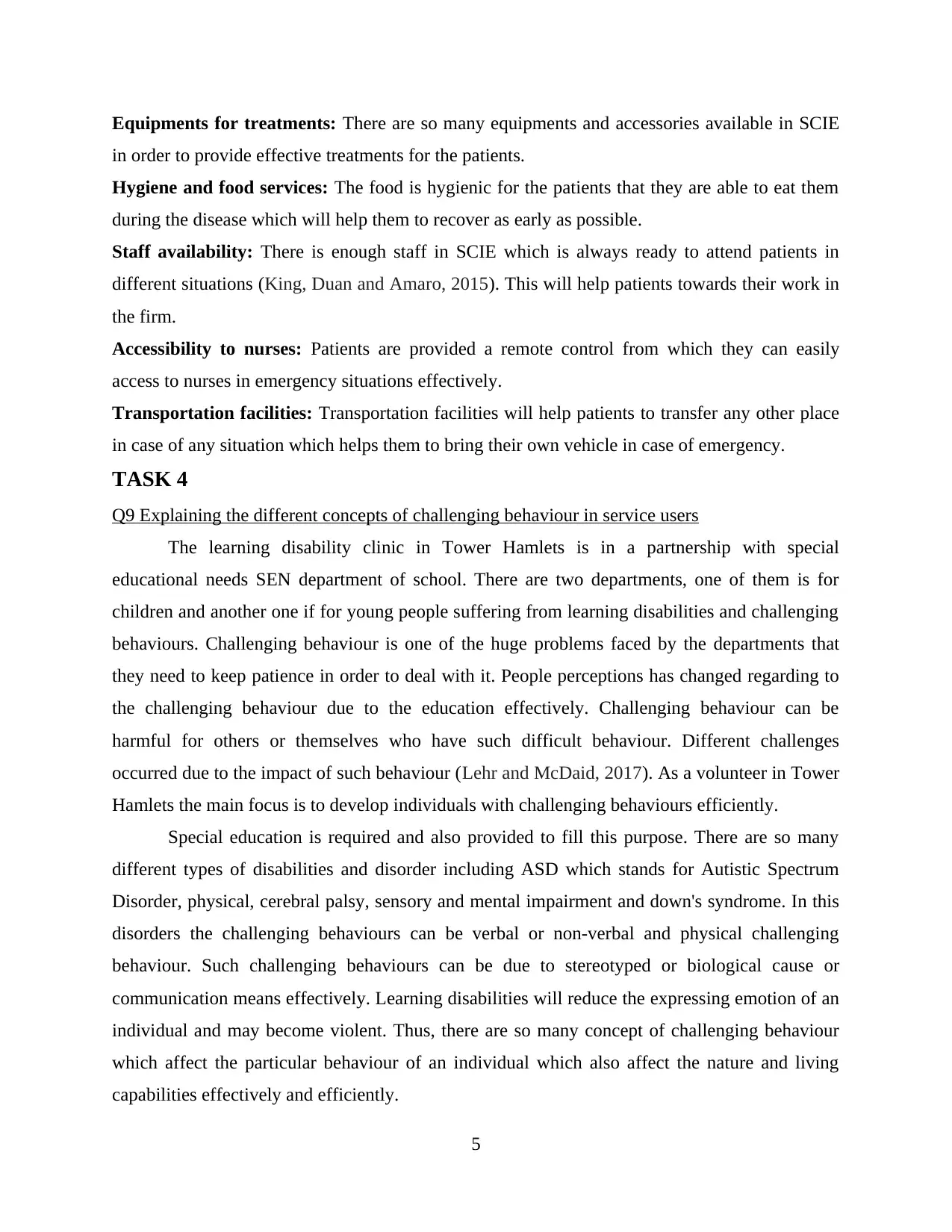
Equipments for treatments: There are so many equipments and accessories available in SCIE
in order to provide effective treatments for the patients.
Hygiene and food services: The food is hygienic for the patients that they are able to eat them
during the disease which will help them to recover as early as possible.
Staff availability: There is enough staff in SCIE which is always ready to attend patients in
different situations (King, Duan and Amaro, 2015). This will help patients towards their work in
the firm.
Accessibility to nurses: Patients are provided a remote control from which they can easily
access to nurses in emergency situations effectively.
Transportation facilities: Transportation facilities will help patients to transfer any other place
in case of any situation which helps them to bring their own vehicle in case of emergency.
TASK 4
Q9 Explaining the different concepts of challenging behaviour in service users
The learning disability clinic in Tower Hamlets is in a partnership with special
educational needs SEN department of school. There are two departments, one of them is for
children and another one if for young people suffering from learning disabilities and challenging
behaviours. Challenging behaviour is one of the huge problems faced by the departments that
they need to keep patience in order to deal with it. People perceptions has changed regarding to
the challenging behaviour due to the education effectively. Challenging behaviour can be
harmful for others or themselves who have such difficult behaviour. Different challenges
occurred due to the impact of such behaviour (Lehr and McDaid, 2017). As a volunteer in Tower
Hamlets the main focus is to develop individuals with challenging behaviours efficiently.
Special education is required and also provided to fill this purpose. There are so many
different types of disabilities and disorder including ASD which stands for Autistic Spectrum
Disorder, physical, cerebral palsy, sensory and mental impairment and down's syndrome. In this
disorders the challenging behaviours can be verbal or non-verbal and physical challenging
behaviour. Such challenging behaviours can be due to stereotyped or biological cause or
communication means effectively. Learning disabilities will reduce the expressing emotion of an
individual and may become violent. Thus, there are so many concept of challenging behaviour
which affect the particular behaviour of an individual which also affect the nature and living
capabilities effectively and efficiently.
5
in order to provide effective treatments for the patients.
Hygiene and food services: The food is hygienic for the patients that they are able to eat them
during the disease which will help them to recover as early as possible.
Staff availability: There is enough staff in SCIE which is always ready to attend patients in
different situations (King, Duan and Amaro, 2015). This will help patients towards their work in
the firm.
Accessibility to nurses: Patients are provided a remote control from which they can easily
access to nurses in emergency situations effectively.
Transportation facilities: Transportation facilities will help patients to transfer any other place
in case of any situation which helps them to bring their own vehicle in case of emergency.
TASK 4
Q9 Explaining the different concepts of challenging behaviour in service users
The learning disability clinic in Tower Hamlets is in a partnership with special
educational needs SEN department of school. There are two departments, one of them is for
children and another one if for young people suffering from learning disabilities and challenging
behaviours. Challenging behaviour is one of the huge problems faced by the departments that
they need to keep patience in order to deal with it. People perceptions has changed regarding to
the challenging behaviour due to the education effectively. Challenging behaviour can be
harmful for others or themselves who have such difficult behaviour. Different challenges
occurred due to the impact of such behaviour (Lehr and McDaid, 2017). As a volunteer in Tower
Hamlets the main focus is to develop individuals with challenging behaviours efficiently.
Special education is required and also provided to fill this purpose. There are so many
different types of disabilities and disorder including ASD which stands for Autistic Spectrum
Disorder, physical, cerebral palsy, sensory and mental impairment and down's syndrome. In this
disorders the challenging behaviours can be verbal or non-verbal and physical challenging
behaviour. Such challenging behaviours can be due to stereotyped or biological cause or
communication means effectively. Learning disabilities will reduce the expressing emotion of an
individual and may become violent. Thus, there are so many concept of challenging behaviour
which affect the particular behaviour of an individual which also affect the nature and living
capabilities effectively and efficiently.
5
Paraphrase This Document
Need a fresh take? Get an instant paraphrase of this document with our AI Paraphraser
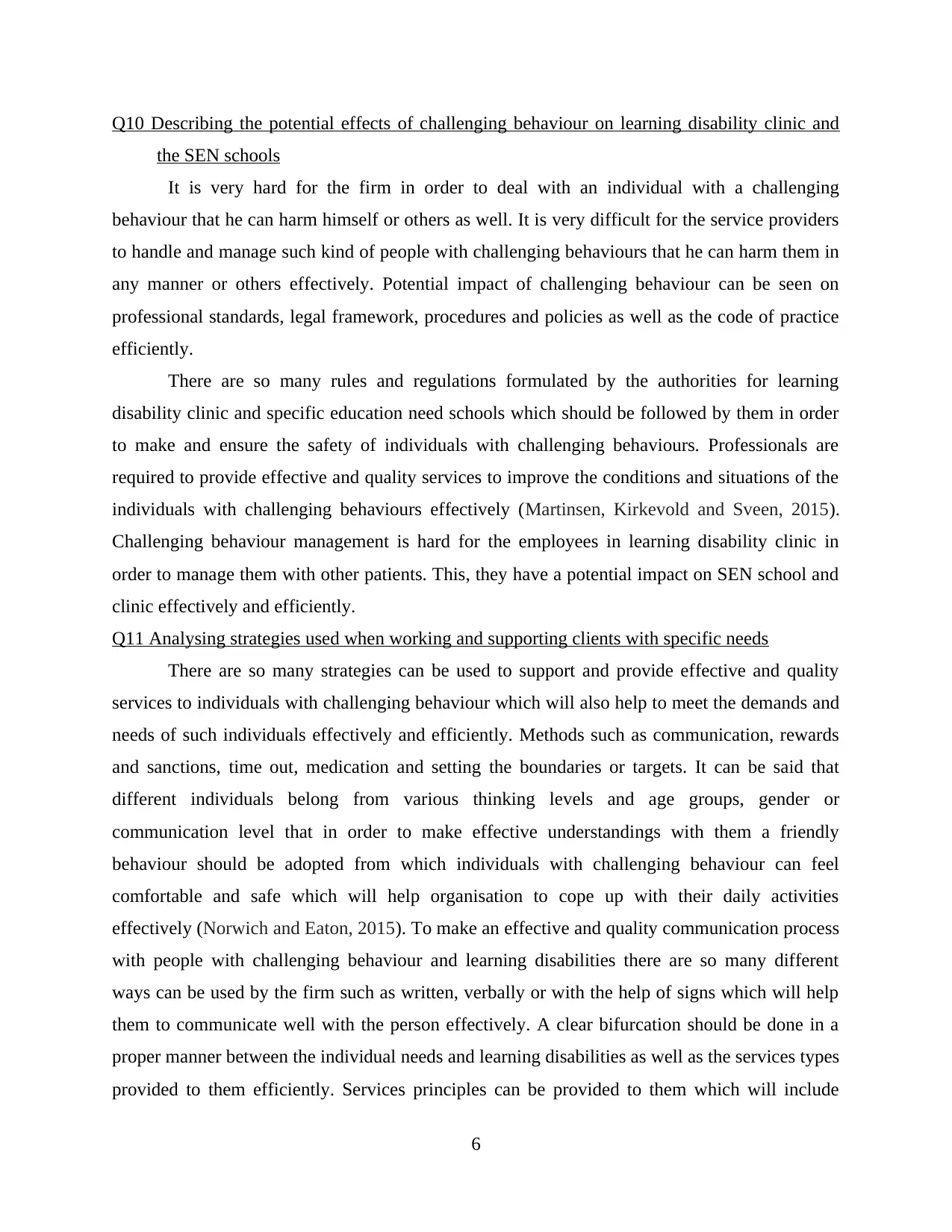
Q10 Describing the potential effects of challenging behaviour on learning disability clinic and
the SEN schools
It is very hard for the firm in order to deal with an individual with a challenging
behaviour that he can harm himself or others as well. It is very difficult for the service providers
to handle and manage such kind of people with challenging behaviours that he can harm them in
any manner or others effectively. Potential impact of challenging behaviour can be seen on
professional standards, legal framework, procedures and policies as well as the code of practice
efficiently.
There are so many rules and regulations formulated by the authorities for learning
disability clinic and specific education need schools which should be followed by them in order
to make and ensure the safety of individuals with challenging behaviours. Professionals are
required to provide effective and quality services to improve the conditions and situations of the
individuals with challenging behaviours effectively (Martinsen, Kirkevold and Sveen, 2015).
Challenging behaviour management is hard for the employees in learning disability clinic in
order to manage them with other patients. This, they have a potential impact on SEN school and
clinic effectively and efficiently.
Q11 Analysing strategies used when working and supporting clients with specific needs
There are so many strategies can be used to support and provide effective and quality
services to individuals with challenging behaviour which will also help to meet the demands and
needs of such individuals effectively and efficiently. Methods such as communication, rewards
and sanctions, time out, medication and setting the boundaries or targets. It can be said that
different individuals belong from various thinking levels and age groups, gender or
communication level that in order to make effective understandings with them a friendly
behaviour should be adopted from which individuals with challenging behaviour can feel
comfortable and safe which will help organisation to cope up with their daily activities
effectively (Norwich and Eaton, 2015). To make an effective and quality communication process
with people with challenging behaviour and learning disabilities there are so many different
ways can be used by the firm such as written, verbally or with the help of signs which will help
them to communicate well with the person effectively. A clear bifurcation should be done in a
proper manner between the individual needs and learning disabilities as well as the services types
provided to them efficiently. Services principles can be provided to them which will include
6
the SEN schools
It is very hard for the firm in order to deal with an individual with a challenging
behaviour that he can harm himself or others as well. It is very difficult for the service providers
to handle and manage such kind of people with challenging behaviours that he can harm them in
any manner or others effectively. Potential impact of challenging behaviour can be seen on
professional standards, legal framework, procedures and policies as well as the code of practice
efficiently.
There are so many rules and regulations formulated by the authorities for learning
disability clinic and specific education need schools which should be followed by them in order
to make and ensure the safety of individuals with challenging behaviours. Professionals are
required to provide effective and quality services to improve the conditions and situations of the
individuals with challenging behaviours effectively (Martinsen, Kirkevold and Sveen, 2015).
Challenging behaviour management is hard for the employees in learning disability clinic in
order to manage them with other patients. This, they have a potential impact on SEN school and
clinic effectively and efficiently.
Q11 Analysing strategies used when working and supporting clients with specific needs
There are so many strategies can be used to support and provide effective and quality
services to individuals with challenging behaviour which will also help to meet the demands and
needs of such individuals effectively and efficiently. Methods such as communication, rewards
and sanctions, time out, medication and setting the boundaries or targets. It can be said that
different individuals belong from various thinking levels and age groups, gender or
communication level that in order to make effective understandings with them a friendly
behaviour should be adopted from which individuals with challenging behaviour can feel
comfortable and safe which will help organisation to cope up with their daily activities
effectively (Norwich and Eaton, 2015). To make an effective and quality communication process
with people with challenging behaviour and learning disabilities there are so many different
ways can be used by the firm such as written, verbally or with the help of signs which will help
them to communicate well with the person effectively. A clear bifurcation should be done in a
proper manner between the individual needs and learning disabilities as well as the services types
provided to them efficiently. Services principles can be provided to them which will include
6
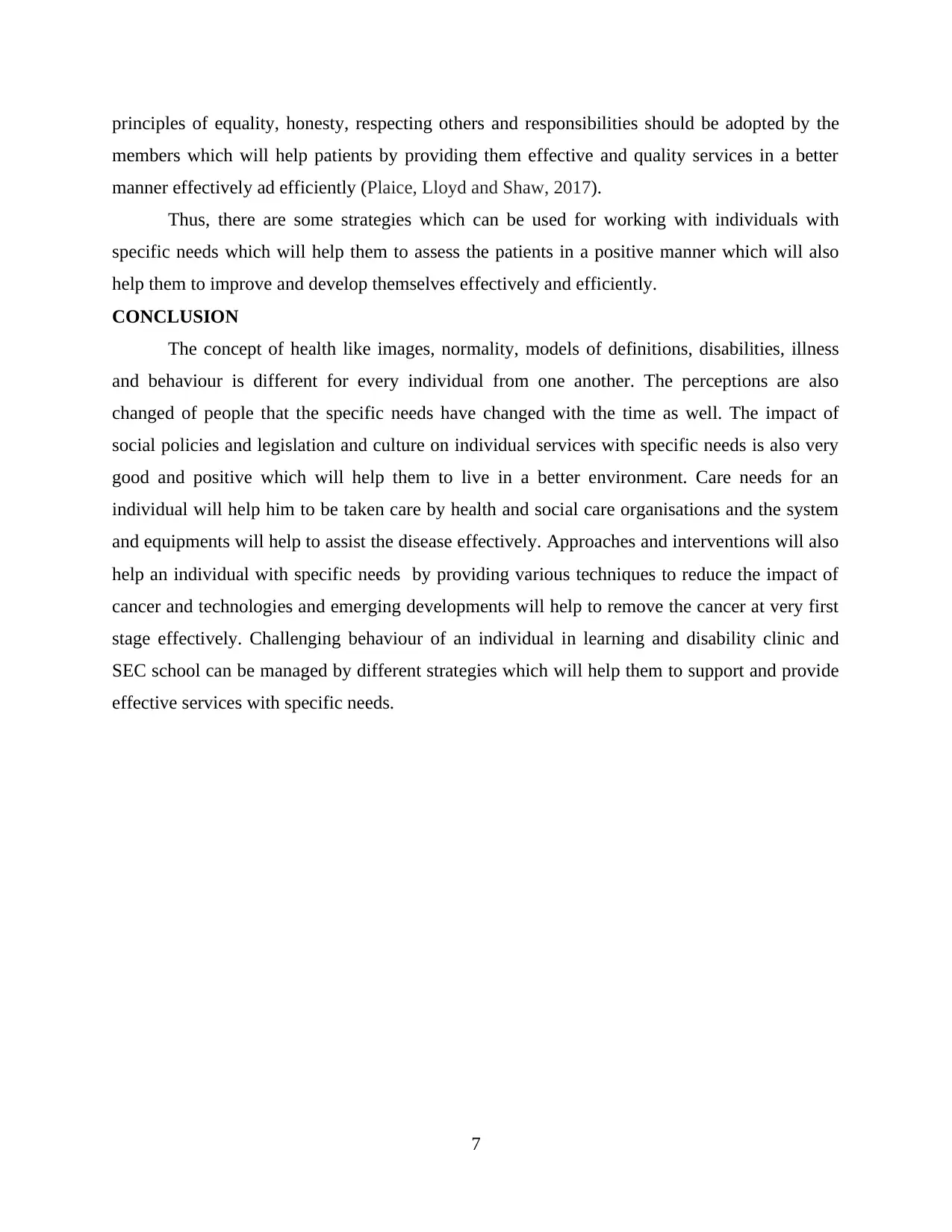
principles of equality, honesty, respecting others and responsibilities should be adopted by the
members which will help patients by providing them effective and quality services in a better
manner effectively ad efficiently (Plaice, Lloyd and Shaw, 2017).
Thus, there are some strategies which can be used for working with individuals with
specific needs which will help them to assess the patients in a positive manner which will also
help them to improve and develop themselves effectively and efficiently.
CONCLUSION
The concept of health like images, normality, models of definitions, disabilities, illness
and behaviour is different for every individual from one another. The perceptions are also
changed of people that the specific needs have changed with the time as well. The impact of
social policies and legislation and culture on individual services with specific needs is also very
good and positive which will help them to live in a better environment. Care needs for an
individual will help him to be taken care by health and social care organisations and the system
and equipments will help to assist the disease effectively. Approaches and interventions will also
help an individual with specific needs by providing various techniques to reduce the impact of
cancer and technologies and emerging developments will help to remove the cancer at very first
stage effectively. Challenging behaviour of an individual in learning and disability clinic and
SEC school can be managed by different strategies which will help them to support and provide
effective services with specific needs.
7
members which will help patients by providing them effective and quality services in a better
manner effectively ad efficiently (Plaice, Lloyd and Shaw, 2017).
Thus, there are some strategies which can be used for working with individuals with
specific needs which will help them to assess the patients in a positive manner which will also
help them to improve and develop themselves effectively and efficiently.
CONCLUSION
The concept of health like images, normality, models of definitions, disabilities, illness
and behaviour is different for every individual from one another. The perceptions are also
changed of people that the specific needs have changed with the time as well. The impact of
social policies and legislation and culture on individual services with specific needs is also very
good and positive which will help them to live in a better environment. Care needs for an
individual will help him to be taken care by health and social care organisations and the system
and equipments will help to assist the disease effectively. Approaches and interventions will also
help an individual with specific needs by providing various techniques to reduce the impact of
cancer and technologies and emerging developments will help to remove the cancer at very first
stage effectively. Challenging behaviour of an individual in learning and disability clinic and
SEC school can be managed by different strategies which will help them to support and provide
effective services with specific needs.
7
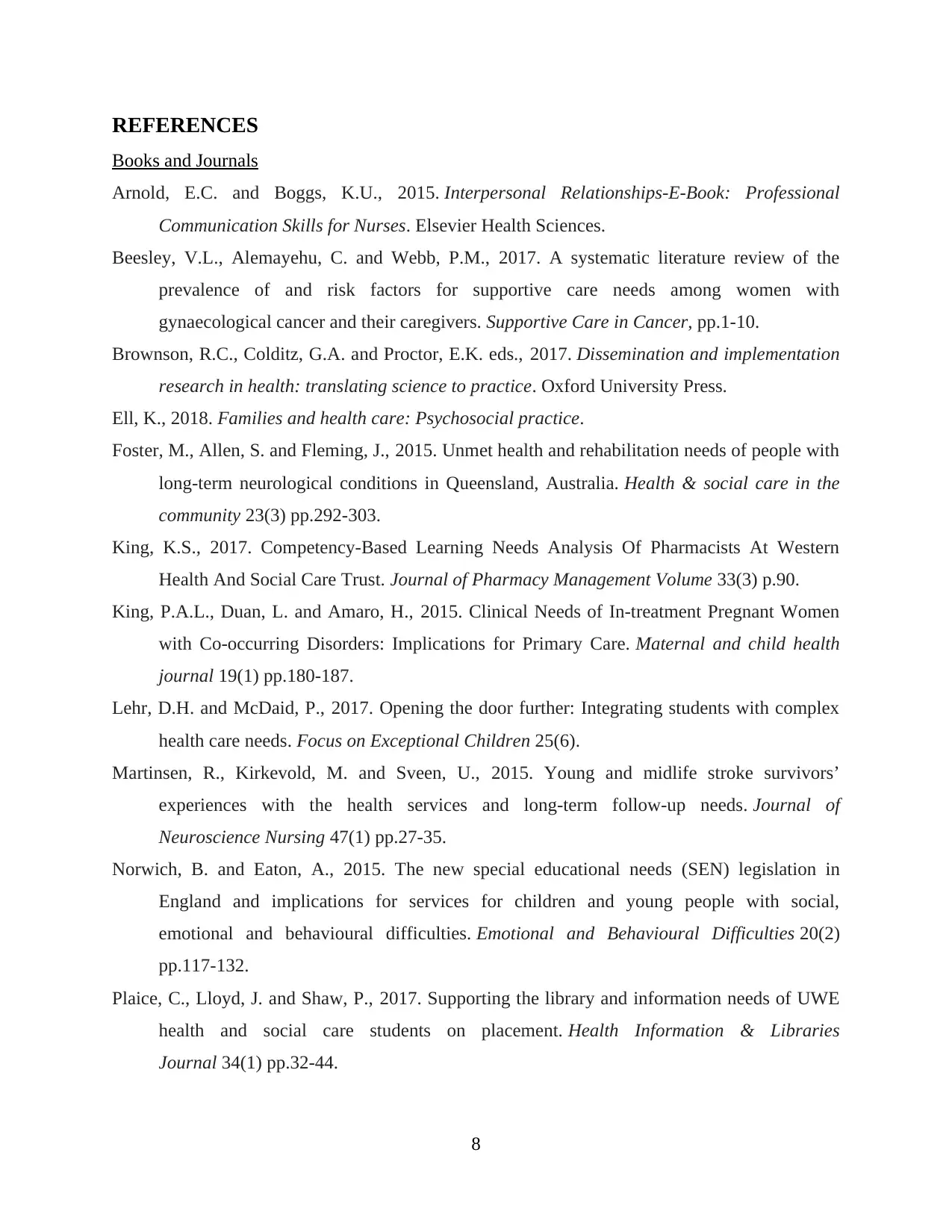
REFERENCES
Books and Journals
Arnold, E.C. and Boggs, K.U., 2015. Interpersonal Relationships-E-Book: Professional
Communication Skills for Nurses. Elsevier Health Sciences.
Beesley, V.L., Alemayehu, C. and Webb, P.M., 2017. A systematic literature review of the
prevalence of and risk factors for supportive care needs among women with
gynaecological cancer and their caregivers. Supportive Care in Cancer, pp.1-10.
Brownson, R.C., Colditz, G.A. and Proctor, E.K. eds., 2017. Dissemination and implementation
research in health: translating science to practice. Oxford University Press.
Ell, K., 2018. Families and health care: Psychosocial practice.
Foster, M., Allen, S. and Fleming, J., 2015. Unmet health and rehabilitation needs of people with
long‐term neurological conditions in Queensland, Australia. Health & social care in the
community 23(3) pp.292-303.
King, K.S., 2017. Competency-Based Learning Needs Analysis Of Pharmacists At Western
Health And Social Care Trust. Journal of Pharmacy Management Volume 33(3) p.90.
King, P.A.L., Duan, L. and Amaro, H., 2015. Clinical Needs of In-treatment Pregnant Women
with Co-occurring Disorders: Implications for Primary Care. Maternal and child health
journal 19(1) pp.180-187.
Lehr, D.H. and McDaid, P., 2017. Opening the door further: Integrating students with complex
health care needs. Focus on Exceptional Children 25(6).
Martinsen, R., Kirkevold, M. and Sveen, U., 2015. Young and midlife stroke survivors’
experiences with the health services and long-term follow-up needs. Journal of
Neuroscience Nursing 47(1) pp.27-35.
Norwich, B. and Eaton, A., 2015. The new special educational needs (SEN) legislation in
England and implications for services for children and young people with social,
emotional and behavioural difficulties. Emotional and Behavioural Difficulties 20(2)
pp.117-132.
Plaice, C., Lloyd, J. and Shaw, P., 2017. Supporting the library and information needs of UWE
health and social care students on placement. Health Information & Libraries
Journal 34(1) pp.32-44.
8
Books and Journals
Arnold, E.C. and Boggs, K.U., 2015. Interpersonal Relationships-E-Book: Professional
Communication Skills for Nurses. Elsevier Health Sciences.
Beesley, V.L., Alemayehu, C. and Webb, P.M., 2017. A systematic literature review of the
prevalence of and risk factors for supportive care needs among women with
gynaecological cancer and their caregivers. Supportive Care in Cancer, pp.1-10.
Brownson, R.C., Colditz, G.A. and Proctor, E.K. eds., 2017. Dissemination and implementation
research in health: translating science to practice. Oxford University Press.
Ell, K., 2018. Families and health care: Psychosocial practice.
Foster, M., Allen, S. and Fleming, J., 2015. Unmet health and rehabilitation needs of people with
long‐term neurological conditions in Queensland, Australia. Health & social care in the
community 23(3) pp.292-303.
King, K.S., 2017. Competency-Based Learning Needs Analysis Of Pharmacists At Western
Health And Social Care Trust. Journal of Pharmacy Management Volume 33(3) p.90.
King, P.A.L., Duan, L. and Amaro, H., 2015. Clinical Needs of In-treatment Pregnant Women
with Co-occurring Disorders: Implications for Primary Care. Maternal and child health
journal 19(1) pp.180-187.
Lehr, D.H. and McDaid, P., 2017. Opening the door further: Integrating students with complex
health care needs. Focus on Exceptional Children 25(6).
Martinsen, R., Kirkevold, M. and Sveen, U., 2015. Young and midlife stroke survivors’
experiences with the health services and long-term follow-up needs. Journal of
Neuroscience Nursing 47(1) pp.27-35.
Norwich, B. and Eaton, A., 2015. The new special educational needs (SEN) legislation in
England and implications for services for children and young people with social,
emotional and behavioural difficulties. Emotional and Behavioural Difficulties 20(2)
pp.117-132.
Plaice, C., Lloyd, J. and Shaw, P., 2017. Supporting the library and information needs of UWE
health and social care students on placement. Health Information & Libraries
Journal 34(1) pp.32-44.
8
Secure Best Marks with AI Grader
Need help grading? Try our AI Grader for instant feedback on your assignments.
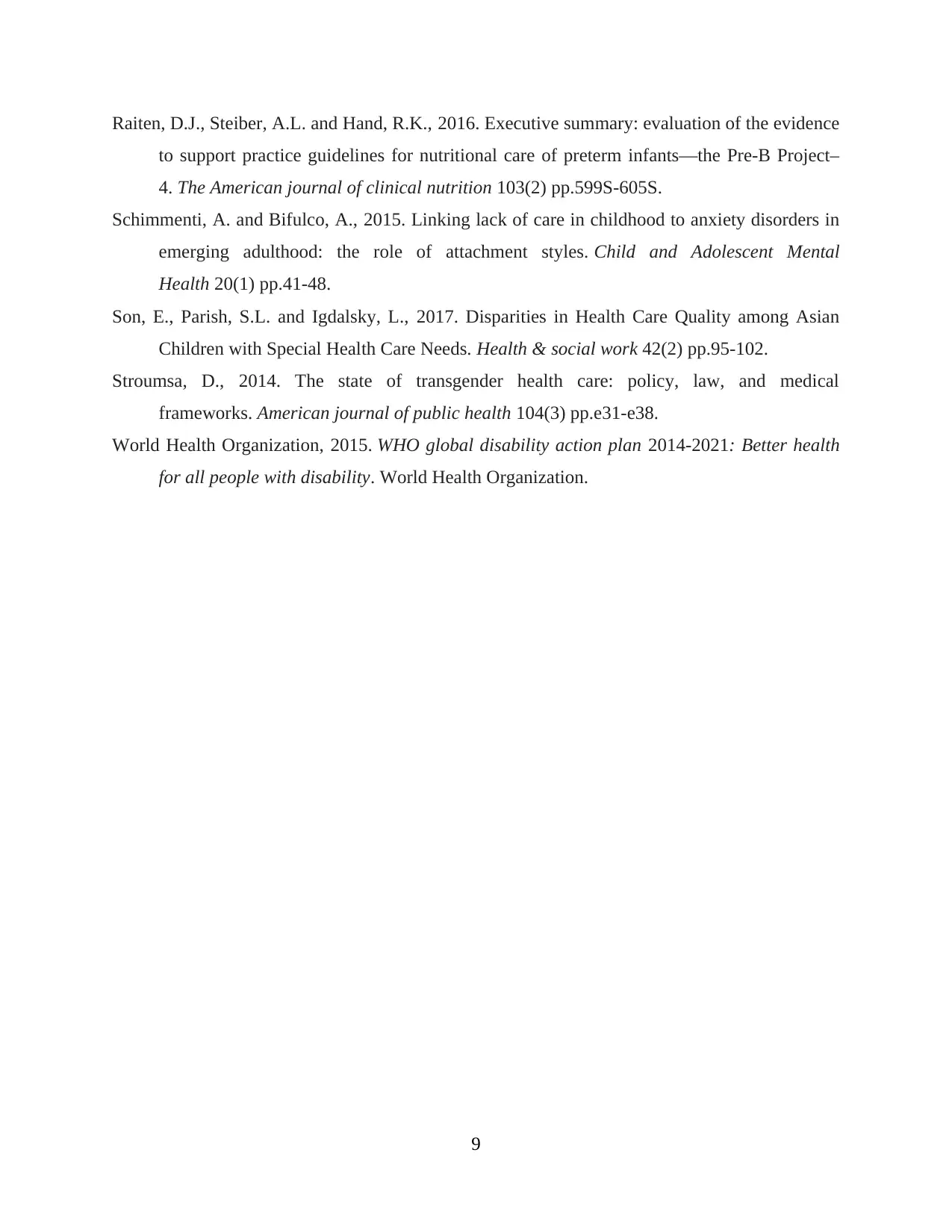
Raiten, D.J., Steiber, A.L. and Hand, R.K., 2016. Executive summary: evaluation of the evidence
to support practice guidelines for nutritional care of preterm infants—the Pre-B Project–
4. The American journal of clinical nutrition 103(2) pp.599S-605S.
Schimmenti, A. and Bifulco, A., 2015. Linking lack of care in childhood to anxiety disorders in
emerging adulthood: the role of attachment styles. Child and Adolescent Mental
Health 20(1) pp.41-48.
Son, E., Parish, S.L. and Igdalsky, L., 2017. Disparities in Health Care Quality among Asian
Children with Special Health Care Needs. Health & social work 42(2) pp.95-102.
Stroumsa, D., 2014. The state of transgender health care: policy, law, and medical
frameworks. American journal of public health 104(3) pp.e31-e38.
World Health Organization, 2015. WHO global disability action plan 2014-2021: Better health
for all people with disability. World Health Organization.
9
to support practice guidelines for nutritional care of preterm infants—the Pre-B Project–
4. The American journal of clinical nutrition 103(2) pp.599S-605S.
Schimmenti, A. and Bifulco, A., 2015. Linking lack of care in childhood to anxiety disorders in
emerging adulthood: the role of attachment styles. Child and Adolescent Mental
Health 20(1) pp.41-48.
Son, E., Parish, S.L. and Igdalsky, L., 2017. Disparities in Health Care Quality among Asian
Children with Special Health Care Needs. Health & social work 42(2) pp.95-102.
Stroumsa, D., 2014. The state of transgender health care: policy, law, and medical
frameworks. American journal of public health 104(3) pp.e31-e38.
World Health Organization, 2015. WHO global disability action plan 2014-2021: Better health
for all people with disability. World Health Organization.
9
1 out of 11
Related Documents
Your All-in-One AI-Powered Toolkit for Academic Success.
+13062052269
info@desklib.com
Available 24*7 on WhatsApp / Email
![[object Object]](/_next/static/media/star-bottom.7253800d.svg)
Unlock your academic potential
© 2024 | Zucol Services PVT LTD | All rights reserved.





